warning CITROEN C6 2012 Handbook (in English)
[x] Cancel search | Manufacturer: CITROEN, Model Year: 2012, Model line: C6, Model: CITROEN C6 2012Pages: 216, PDF Size: 10.23 MB
Page 72 of 216
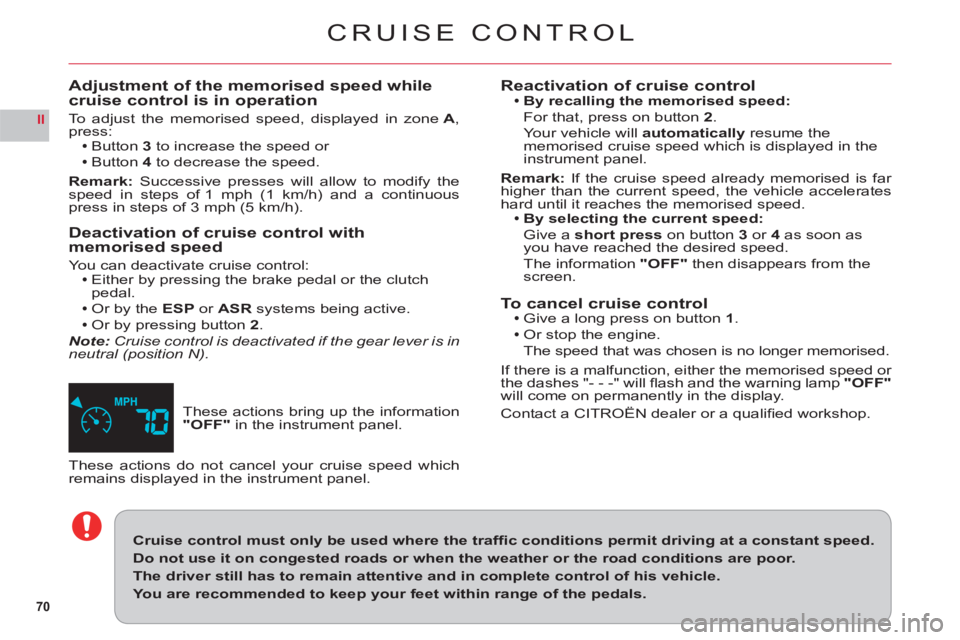
70
II
CRUISE CONTROL
These actions bring up the information "OFF"in the instrument panel.
Adjustment of the memorised speed whilecruise control is in operation
To adjust the memorised speed, displayed in zone A, press:Button 3 to increase the speed or
Button 4 to decrease the speed.
Remark: Successive presses will allow to modify the speed in steps of 1 mph (1 km/h) and a continuous press in steps of 3 mph (5 km/h).
Deactivation of cruise control withmemorised speed
Yo u can deactivate cruise control:Either by pressing the brake pedal or the clutchpedal.Or by the ESP or ASR systems being active.
Or by pressing button2.Note:Cruise control is deactivated if the gear lever is in
neutral (position N).
These actions do not cancel your cruise speed which remains displayed in the instrument panel.
Cruise control must only be used where the traffi c conditions permit driving at a constant speed.
Do not use it on congested roads or when the weather or the road conditions are poor.
The driver still has to remain attentive and in complete control of his vehicle.
You are recommended to keep your feet within range of the pedals.
Reactivation of cruise controlBy recalling the memorised speed:
For that, press on button 2.
Yo ur vehicle willautomatically resume the
memorised cruise speed which is displayed in the instrument panel.
Remark
:If the cruise speed already memorised is far higher than the current speed, the vehicle accelerateshard until it reaches the memorised speed.By selecting the current speed:
Give ashort press on button 3or 4as soon asyou have reached the desired speed.
Th
e information "OFF"then disappears from the screen.
To cancel cruise controlGive a long press on button 1.
Or stop the engine.
The speed that was chosen is no lon
ger memorised.
If there is a malfunction, either the memorised speed or
the dashes "- - -" will fl ash and the warning lamp "OFF"
will come on permanently in the display.
Contact a CITROËN dealer or a qualifi ed workshop.
Page 74 of 216
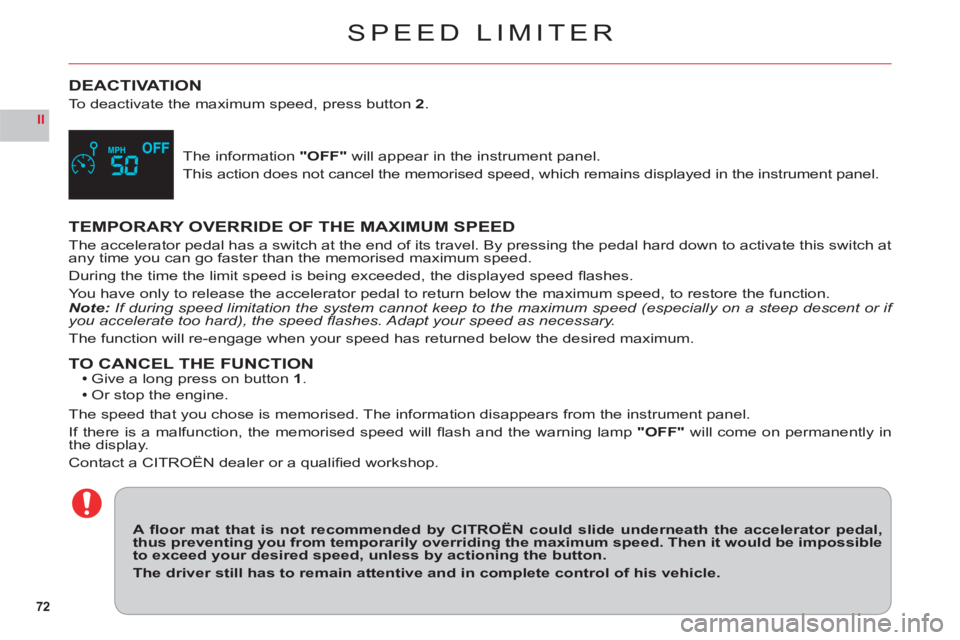
72
II
SPEED LIMITER
DEACTIVATION
To deactivate the maximum speed, press button2.
The information "OFF" will appear in the instrument panel.
This action does not cancel the memorised speed, which remains displayed in the instrument panel.
TEMPORARY OVERRIDE OF THE MAXIMUM SPEED
The accelerator pedal has a switch at the end of its travel. By pressing the pedal hard down to activate this switch at
any time you can go faster than the memorised maximum speed.
Durin
g the time the limit speed is being exceeded, the displayed speed fl ashes.
You have only to release the accelerator pedal to return below the maximum speed, to restore the function.Note:If during speed limitation the system cannot keep to the maximum speed (especially on a steep descent or if
you accelerate too hard), the speed fl ashes. Adapt your speed as necessary.
The function will re-engage when your speed has returned below the desired maximum.
TO CANCEL THE FUNCTIONGive a long press on button1.Or stop the engine.
The speed that you chose is memorised. The information disappears from the instrument panel.
I
f there is a malfunction, the memorised speed will fl ash and the warning lamp "OFF" will come on permanently in
the display.
Contact a CITROËN dealer or a qualifi ed workshop.
A fl oor mat that is not recommended by CITROËN could slide underneath the accelerator pedal,thus preventing you from temporarily overriding the maximum speed. Then it would be impossibleto exceed your desired speed, unless by actioning the button.
The driver still has to remain attentive and in complete control of his vehicle.
Page 75 of 216
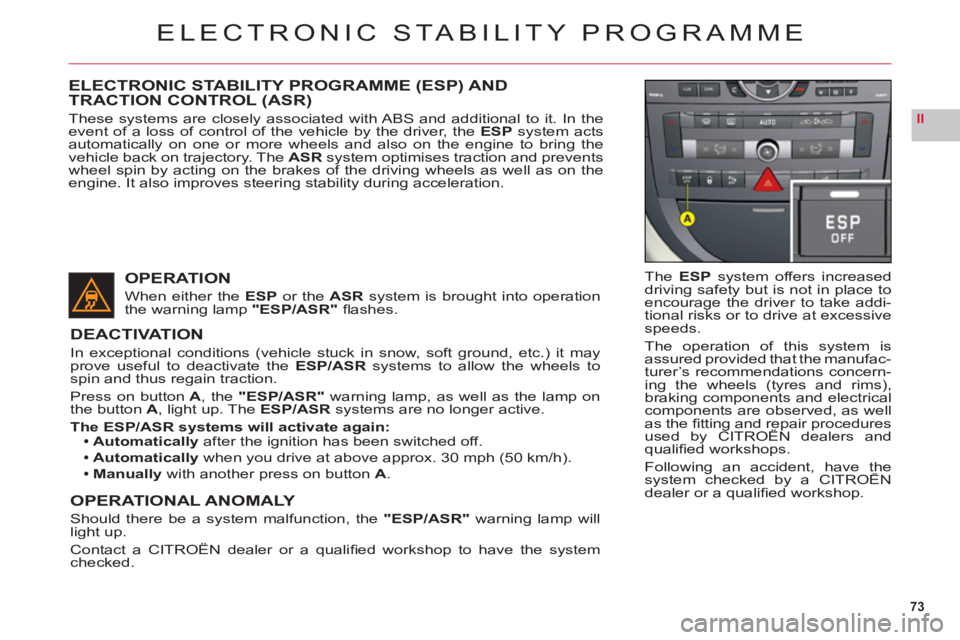
73
II
ELECTRONIC STABILITY PROGRAMME
TheESP system offers increased
driving safety but is not in place toencourage the driver to take addi-
tional risks or to drive at excessivespeeds.
The operation of this s
ystem is
assured provided that the manufac-
turer’s recommendations concern-
ing the wheels (tyres and rims),
braking components and electricalcomponents are observed, as wellas the fi tting and repair proceduresused by CITROËN dealers andgpp
qualifi ed workshops.
Following an accident, have thesystem checked by a CITROËNg,
dealer or a qualifi ed workshop.
ELECTRONIC STABILITY PROGRAMME (ESP) AND TRACTION CONTROL (ASR)
These systems are closely associated with ABS and additional to it. In the event of a loss of control of the vehicle by the driver, theESPsystem acts
automatically on one or more wheels and also on the engine to bring the
vehicle back on trajectory. The ASRsystem optimises traction and prevents
wheel spin by acting on the brakes of the driving wheels as well as on the engine. It also improves steering stability during acceleration.
OPERATION
When either the ESPor the ASR system is brought into operation
the warning lamp "ESP/ASR" fl ashes.
DEACTIVATION
In exceptional conditions (vehicle stuck in snow, soft ground, etc.) it mayprove useful to deactivate theESP/ASR systems to allow the wheels tospin and thus regain traction.
Press on buttonA, the"ESP/ASR" warning lamp, as well as the lamp on
the buttonA, light up. TheESP/ASR systems are no longer active.
The ESP/ASR systems will activate again:Automatically after the ignition has been switched off.
Automatically when you drive at above approx. 30 mph (50 km/h).
Manuallywith another press on button A.
OPERATIONAL ANOMALY
Should there be a system malfunction, the "ESP/ASR"warning lamp willlight up.
Contact a CITROËN dealer or a qualifi ed workshop to have the systemchecked.
Page 76 of 216
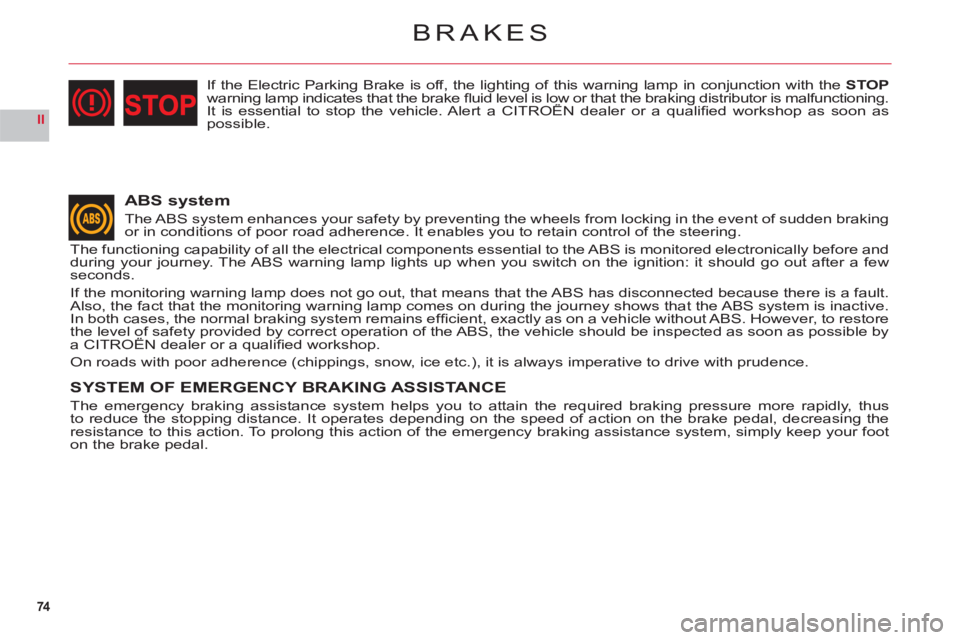
74
II
BRAKES
ABS system
The ABS system enhances your safety by preventing the wheels from locking in the event of sudden brakingor in conditions of poor road adherence. It enables you to retain control of the steering.
The
functioning capability of all the electrical components essential to the ABS is monitored electronically before and
during your journey. The ABS warning lamp lights up when you switch on the ignition: it should go out after a fewseconds.
If the monitoring warning lamp does not go out, that means that the ABS has disconnected because there is a fault.Also, the fact that the monitoring warning lamp comes on during the journey shows that the ABS system is inactive.
In both cases, the normal braking system remains effi cient, exactly as on a vehicle without ABS. However, to restorethe level of safety provided by correct operation of the ABS, the vehicle should be inspected as soon as possible bya CITROÀN dealer or a qualifi ed workshop.yp y p
On roads with poor adherence (chippings, snow, ice etc.), it is always imperative to drive with prudence.
SYSTEM OF EMERGENCY BRAKING ASSISTANCE
The emergency braking assistance system helps you to attain the required braking pressure more rapidly, thus
to reduce the stopping distance. It operates depending on the speed of action on the brake pedal, decreasing theresistance to this action. To prolong this action of the emergency braking assistance system, simply keep your foot
on the brake pedal.
If the Electric Parking Brake is off, the lighting of this warning lamp in conjunction with the STOPwarning lamp indicates that the brake fl uid level is low or that the braking distributor is malfunctioning.It is essential to stop the vehicle. Alert a CITROËN dealer or a qualifi ed workshop as soon asgpgg
possible.
Page 77 of 216

75
II
A
ELECTRIC PARKING BRAKE
OPERATION
To park
With the vehicle stationary, operate
the parking brakeby pulling thenreleasing the controlA.Note:In all circumstances with an
automatic gearbox, select the
Park position P.
On steep
gradients, turn the steering towards the pavement.It is not possible to release the electric parking brake if the key is removed or in position S.
•
•
•
To move off
With the engine running, release
the electric parking brake, by pres-
sing the brake pedal or the acce-lerator pedal and pulling then
releasing the control A.
You are advised not to clean underneath the vehicle using ahigh pressure system, as this could damage the electric parkingbrake.
Do not use the accelerator to hold your vehicle while on an incline.Use either the brake pedal or the electric parking brake.
The warning lamp comes
on if the parking brake isonor not properly releasedor if you try to release thebrakewithout pressing on thebrake pedal.
If these two warning
lamps come on
to
gether, this indica-
tes that the electric parking brake is malfunctioning.
The brake is on.
If this warning lamp comes
on, this indicates that the
electric parking brake is malfunctioning.
Th
e brake is not on.With an automatic gearbox, place the gearbox on position P.With a manual gearbox, engage fi rst gear.
•
•
Page 78 of 216
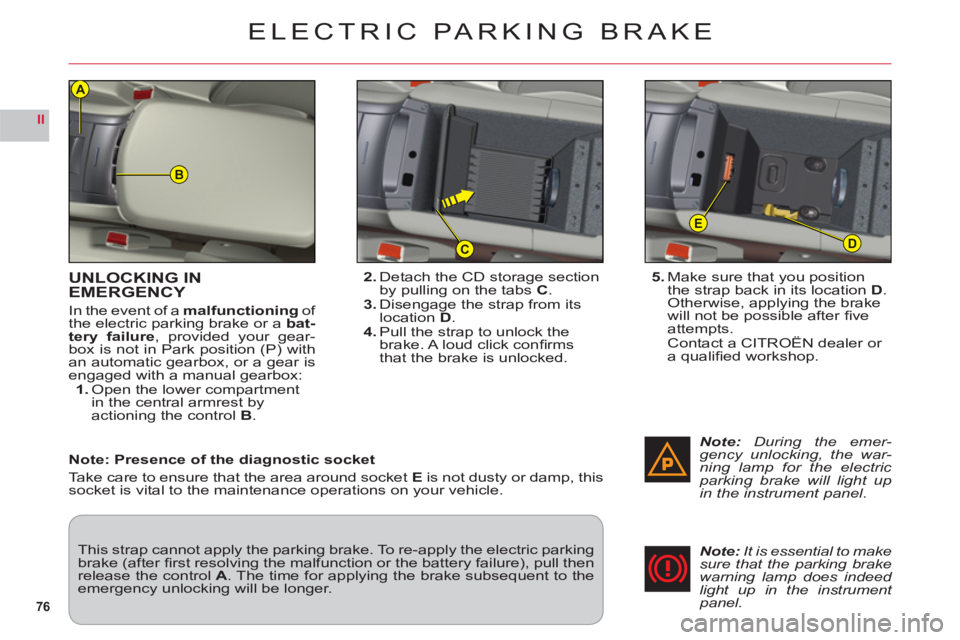
76
II
B
D
E
C
A
UNLOCKING INEMERGENCY
In the event of a malfunctioningof
the electric parking brake or a bat-
tery failure, provided your gear-
box is not in Park position (P) with
an automatic gearbox, or a gear isengaged with a manual gearbox:1.Open the lower compartmentin the central armrest by
actioning the control B.
ELECTRIC PARKING BRAKE
5. Make sure that you position
the strap back in its locationD.Otherwise, applying the brake
will not be possible after fi ve
attempts.Contact a CITROÀN dealer or
a qualifi ed workshop.
This strap cannot apply the parking brake. To re-apply the electric parking brake (after fi rst resolving the malfunction or the battery failure), pull then release the control A. The time for applying the brake subsequent to the emergency unlocking will be longer.
Note:During the emer-gency unlocking, the war-ning lamp for the electric parking brake will light upin the instrument panel.
2.Detach the CD storage sectionby pulling on the tabsC.3. Disengage the strap from itslocationD.4.Pull the strap to unlock the brake. A loud click confi rmsthat the brake is unlocked.
Note: It is essential to makesure that the parking brakewarning lamp does indeed light up in the instrument panel. Note: Presence of the dia
gnostic socket
Take care to ensure that the area around socket Eis not dusty or damp, this socket is vital to the maintenance operations on your vehicle.
Page 80 of 216
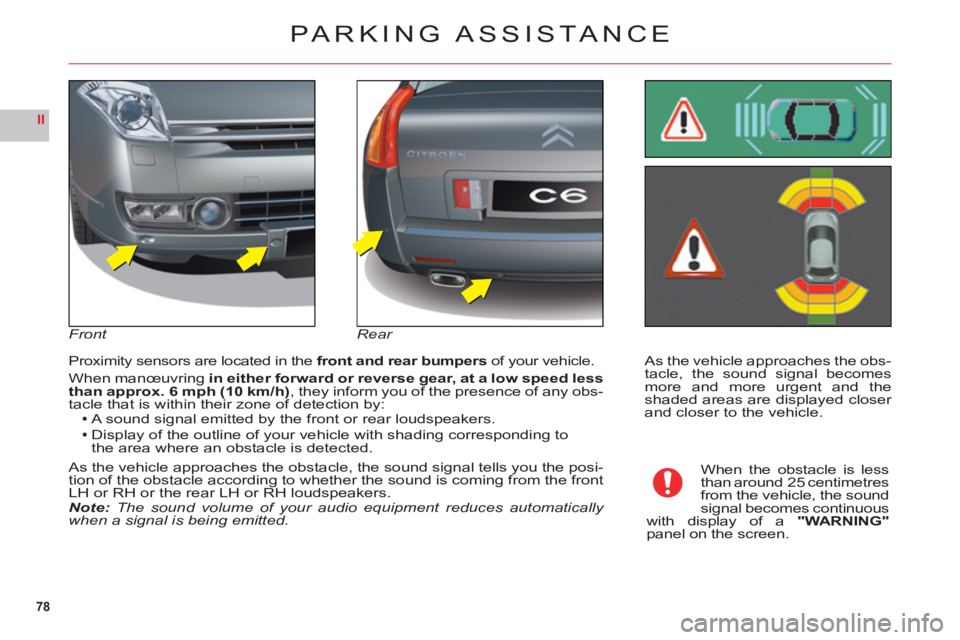
78
II
As the vehicle approaches the obs-
tacle, the sound signal becomesmore and more urgent and theshaded areas are displayed closer and closer to the vehicle. Proximit
y sensors are located in the front and rear bumpersof your vehicle.
When manœuvringin either forward or reverse gear, at a low speed less
than approx. 6 mph (10 km/h), they inform you of the presence of any obs-
tacle that is within their zone of detection by: A sound signal emitted by the front or rear loudspeakers.
Display of the outline of your vehicle with shading corresponding to
the area where an obstacle is detected.
As the vehicle approaches the obstacle, the sound signal tells you the posi-
tion of the obstacle according to whether the sound is coming from the front LH or RH or the rear LH or RH loudspeakers.
Note:The sound volume of your audio equipment reduces automatically when a signal is being emitted.
PARKING ASSISTA NCE
FrontRear
When the obstacle is less
than around 25 centimetres
from the vehicle, the sound signal becomes continuous
with display of a"WARNING"panel on the screen.
Page 81 of 216
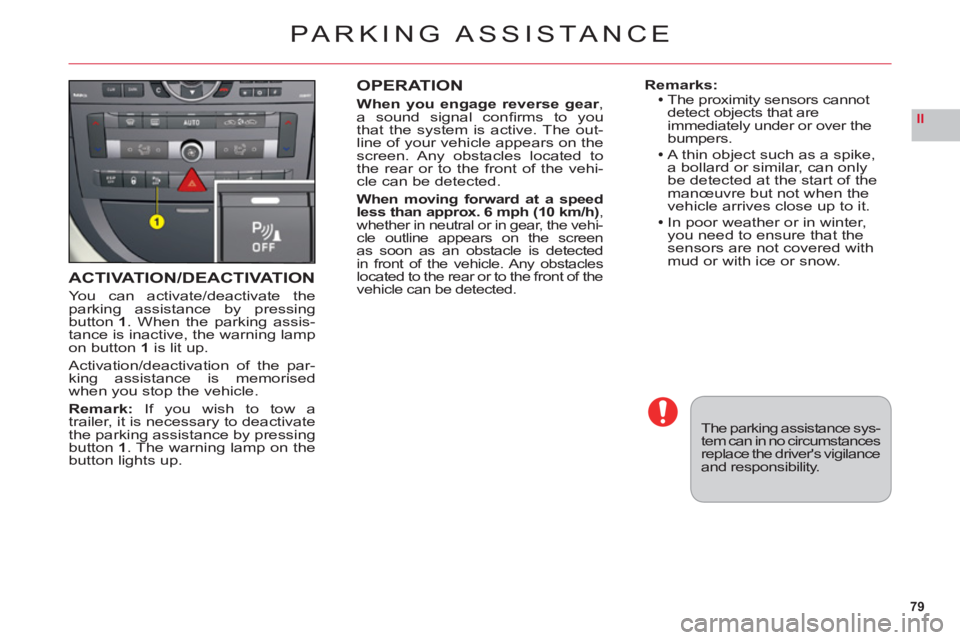
79
II
ACTIVATION/DEACTIVATION
You can activate/deactivate theparking assistance by pressingbutton 1. When the parking assis-
tance is inactive, the warning lampon button1is lit up.
Activation/deactivation of the par-king assistance is memorisedwhen you stop the vehicle.
Remark: If you wish to tow a
trailer, it is necessary to deactivate
the parking assistance by pressing
button 1. The warning lamp on the
button lights up.
OPERATION
When you engage reverse gear,
a sound signal confi rms to you
that the system is active. The out-line of your vehicle appears on the
screen. Any obstacles located to
the rear or to the front of the vehi-cle can be detected.
When moving forward at a speed less than approx. 6 mph (10 km/h),
whether in neutral or in gear, the vehi-cle outline appears on the screen as soon as an obstacle is detected
in front of the vehicle. Any obstacles located to the rear or to the front of the
vehicle can be detected.
Remarks:The proximity sensors cannot
detect objects that are
immediatel
y under or over the
bumpers.
A thin object such as a spike,
a bollard or similar, can only be detected at the start of themanœuvre but not when the
vehicle arrives close up to it.
In poor weather or in winter,you need to ensure that the sensors are not covered with
mud or with ice or snow.
PARKING ASSISTA NCE
The parking assistance sys-tem can in no circumstancesreplace the driver's vigilanceand responsibility.
Page 82 of 216
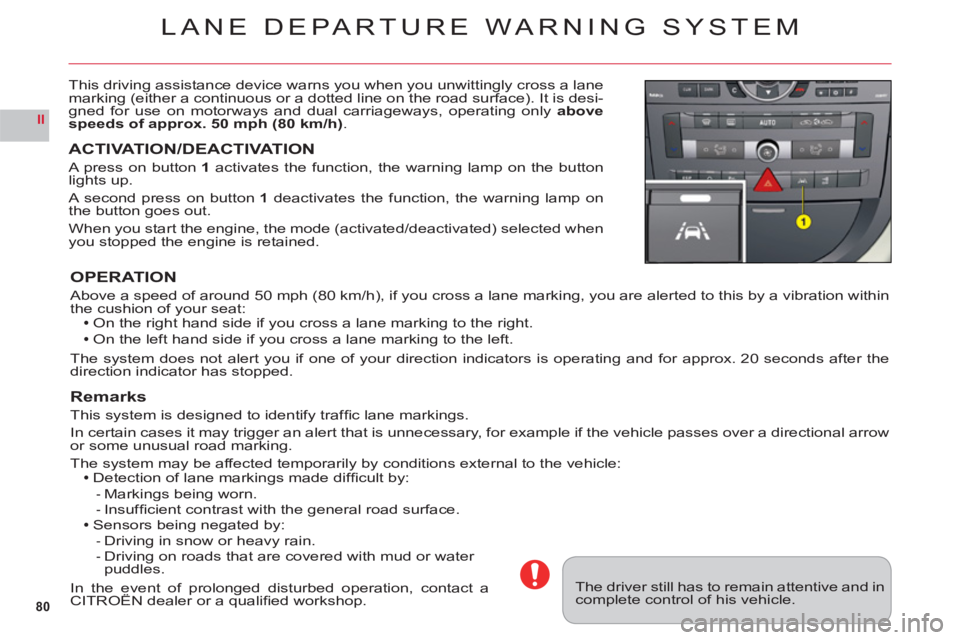
80
II
LANE DEPARTURE WARNING SYSTEM
This driving assistance device warns you when you unwittingly cross a lane marking (either a continuous or a dotted line on the road surface). It is desi-gned for use on motorways and dual carriageways, operating onlyabove
speeds of approx.50 mph (80 km/h).
ACTIVATION/DEACTIVATION
A press on button 1activates the function, the warning lamp on the button lights up.
A second press on button 1 deactivates the function, the warning lamp on
the button goes out.
When you start the engine, the mode (activated/deactivated) selected when you stopped the engine is retained.
OPERATION
Above a speed of around 50 mph (80 km/h), if you cross a lane marking, you are alerted to this by a vibration within
the cushion of your seat:On the right hand side if you cross a lane marking to the right.
On the left hand side if you cross a lane marking to the left.
The system does not alert you if one of your direction indicators is operating and for approx. 20 seconds after the
direction indicator has stopped.
Remarks
This system is designed to identify traffi c lane markings.
In certain cases it ma
y trigger an alert that is unnecessary, for example if the vehicle passes over a directional arrow
or some unusual road marking.
The system may be affected temporarily by conditions external to the vehicle:Detection of lane markings made diffi cult by:
Markings being worn.Insuffi cient contrast with the general road surface.Sensors being negated by:
Driving in snow or heavy rain.Driving on roads that are covered with mud or water puddles.
In the event of prolonged disturbed operation, contact aCITROÀN dealer or a qualifi ed workshop.pg p
--
--
The driver still has to remain attentive and in complete control of his vehicle.
Page 83 of 216
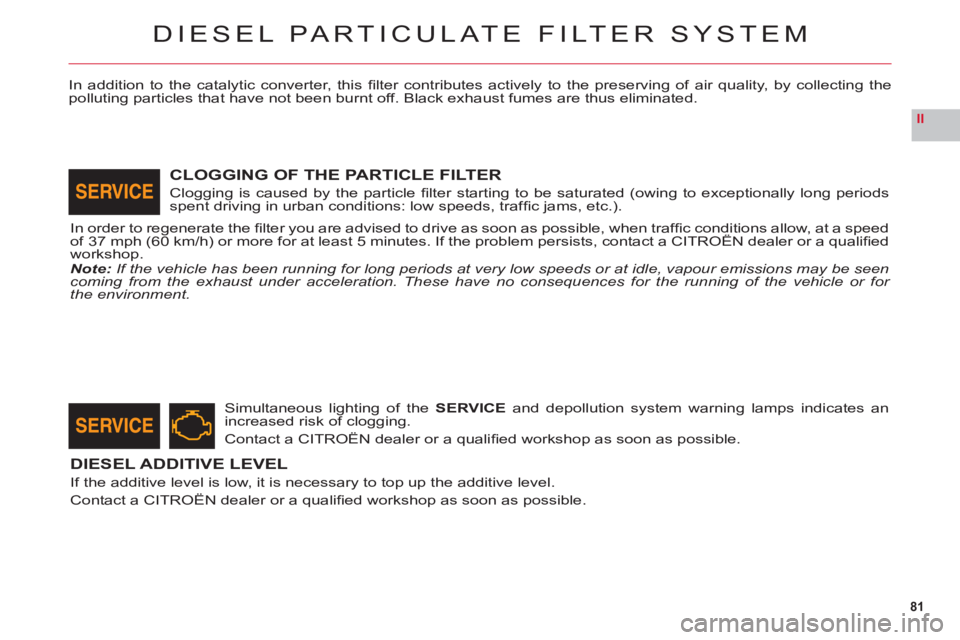
81
II
DIESEL PARTICULATE FILTER SYSTEM
In addition to the catalytic converter, this fi lter contributes actively to the preserving of air quality, by collecting thepolluting particles that have not been burnt off. Black exhaust fumes are thus eliminated.
Simultaneous lighting of the SERVICEand depollution system warning lamps indicates an
increased risk of clogging.
Contact a CITROËN dealer or a qualifi ed workshop as soon as possible.
DIESEL ADDITIVE LEVEL
If the additive level is low, it is necessary to top up the additive level.
Contact a CITROËN dealer or a qualifi ed workshop as soon as possible.
CLOGGING OF THE PARTICLE FILTER
Clogging is caused by the particle fi lter starting to be saturated (owing to exceptionally long periodsspent driving in urban conditions: low speeds, traffi c jams, etc.).
In order to re
generate the fi lter you are advised to drive as soon as possible, when traffi c conditions allow, at a speedof 37 mph (60 km/h) or more for at least 5 minutes. If the problem persists, contact a CITROÀN dealer or a qualifi edgyp,,p
workshop.Note: If the vehicle has been running for long periods at very low speeds or at idle, vapour emissions may be seencoming from the exhaust under acceleration. These have no consequences for the running of the vehicle or for the environment.